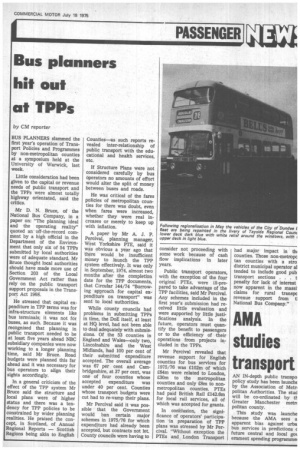Bus planners hit out at TPPs
Page 21

If you've noticed an error in this article please click here to report it so we can fix it.
by CM reporter BUS PLANNERS slammed the first year's operation of Transport Policies and Programmes by non-metropolitan counties at a symposium held at the University of Warwick, last week.
Little consideration had been given to the capital or revenue needs of public transport and the TPPs were almost totally highway orientated, said the critics.
Mr D. N. Bruce, of the National Bus Company, in a paper on: "The planning ideal and the operating reality" quoted an off-the-record comment by a high official in the Department of the Environment that only six of 54 TPPs submitted by local authorities were of adequate standard. Mr Bruce thought local authorities should have made more use of Section 203 of the Local Government Act rather than rely on the public transport support proposals in the Transport Act 1968.
He stressed that capital expenditure in TPP terms was for infra-structure elements like bus terminals; it was not for buses, as such. Because it was recognised that planning in public transport needed to be at least five years ahead NBC subsidiary companies were now working to a longer planning time, said Mr Bruce. Road budgets were planned this far ahead and it was necessary for bus operators to align their sights accordingly.
In a general criticism of the effect of the TPP system Mr Bruce said the structure and local plans were of higher status and there was a tendency for TPP policies to be constrained by wider planning realities. He praised the concept, in Scotland, of Annual Regional Reports — Scottish Regions being akin to English Counties—as such reports revealed inter-relationship of public transport with the educational and health services, etc, If Structure Plans were not considered carefully by bus operators no amounts of effort would alter the split of money between buses and roads.
He was critical of the fares policies of metropolitan counties for there was doubt, even when fares were increased, whether they were real increases or merely to keep up with inflation.
A paper by Mr A. I P. Percival, planning manager, West Yorkshire PTE, said it was obvious a year ago that there would be insufficient money to launch the TPP system effectively. It was only in September, 1974, almost two months after the completion date for the TPP documents, that Circular 144/74 "Borrowing approach for capital expenditure on transport" was sent to local authorities.
While county councils had problems in submitting TPPs in time, the DoE itself, at least at HQ level, had not been able to deal adequately with submissions. Of the 53 counties in England and Wales—only two, Lincolnshire and the West Midlands, had 100 per cent of their submitted expenditure accepted. The overall average was 67 per cent and Cambridgeshire, at 37 per cent, was one of four counties whose accepted expenditure was under 40 per cent. Counties whose transport budgets were cut had to re-vamp their plans.
Mr Percival said it was possible that the Government would ban certain major schemes in 1975/76 for which expenditure had already been accepted, but contracts not let. County councils were having to consider not proceeding with some work because of cash flow implications in later years.
Public transport operators, with the exception of the four original PTEs, were ill-prepared to take advantage of the TPP facilities, said Mr Percival. Any schemes included in the first year's submission had received little evaluation and were supported by little justifications analysis. In the future, operators must quantify the benefit to passengers or to the efficiency of their operations from projects included in the TPPs.
Mr Percival revealed that revenue support for English counties for bus services for 1975/76 was £102m of which £64m were related to London, £30m to the metropolitan counties and only E8m to nonmetropolitan counties. PTEs had paid British Rail £142.6m for local rail services, all of which was accepted for grants.
In conclusion, the significance of operators' participation in preparation of TPP plans was stressed by Mr Percival. "Without exception the PTEs and London Transport had major impact in tilt counties. Those non-rnetropc tan counties with a stro district municipal operator al tended to include good pub transport sections . . . t penalty for lack of interest now apparent in the massir claims for rural transpc revenue support from ti National Bus Company."




























































































